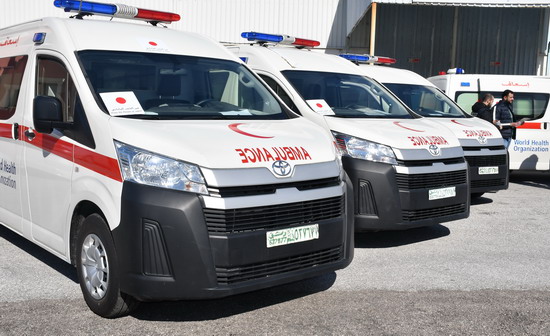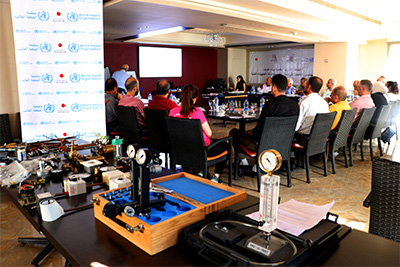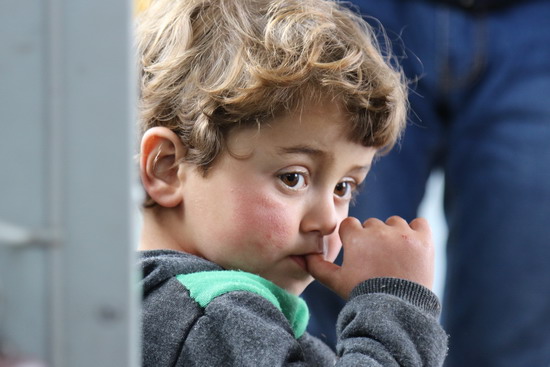WHO welcomes Japan’s donation of 5 ambulances and 2 mobile clinics

 17 February 2020 – WHO handed over 6 equipped ambulances to the Ministries of Health and Higher Education thanks to a generous donation from the Government of Japan. These ambulances are a vital boost to WHO’s efforts to support emergency and ambulance services with a view to improving the health outcomes of internally displaced people and local communities in south and northwest Syria, especially mothers and children, through reducing avoidable morbidity and mortality. In addition to the ambulances and as part of this same initiative, the Japanese Government is also providing 2 mobile clinics that will enhance the provision of primary health care services in the governorates of Aleppo and Al-Qunaitra.
17 February 2020 – WHO handed over 6 equipped ambulances to the Ministries of Health and Higher Education thanks to a generous donation from the Government of Japan. These ambulances are a vital boost to WHO’s efforts to support emergency and ambulance services with a view to improving the health outcomes of internally displaced people and local communities in south and northwest Syria, especially mothers and children, through reducing avoidable morbidity and mortality. In addition to the ambulances and as part of this same initiative, the Japanese Government is also providing 2 mobile clinics that will enhance the provision of primary health care services in the governorates of Aleppo and Al-Qunaitra.
Emergency medical situations require a prompt response and any delay can have serious consequences. The ambulances will strengthen the efforts of the 2 ministries to respond to the health needs of vulnerable people, especially in remote areas, as patients will be able to receive first aid support while on route to the nearest health facility.
“WHO’s priority is to support the Ministry of Health to prevent avoidable loss of life and further complications as a result of injury by providing immediate response and medical treatment to ensure the patients' survival,” said Dr Nima Abid, acting WHO Representative in Syria. “This new donation will be a major boost to enhancing emergency services provision in the country and will play a critical role in strengthening the referral system, a key aspect in the achievement of universal health coverage,” added Dr Abid.
While the 6 ambulances will strengthen the response to emergency and trauma cases and facilitate the referral of patients to hospitals, the 2 mobile clinics will provide primary health care services to rural areas in Aleppo and Al-Qunaitra where the number of returnees has significantly increased. On average, each mobile clinic can serve more than 3000 patients monthly. These include patients suffering from health problems, such as respiratory infections and chronic diseases, in addition to pregnant women and children in need of medical care.
 Based on the Health Resources and Service Availability Monitoring System at WHO (HeRAMS), the status of functionality of assessed public health facilities (hospitals and health centres) at the end of December 2019 was as follows:
Based on the Health Resources and Service Availability Monitoring System at WHO (HeRAMS), the status of functionality of assessed public health facilities (hospitals and health centres) at the end of December 2019 was as follows:
- Across Syria: Out of 1925 assessed public health facilities, 907 (47%) were reported fully functioning, 425 (22%) partially functioning, 593 (31%) non-functioning (completely out of service).
- Across Aleppo governorate: Out of 243 assessed public health facilities, 33 (14%) were reported fully functioning, 49 (20%) partially functioning, 161 (66%) non-functioning.
- Across Dar’a governorate: Out of 112 assessed public health facilities, 18 (16%) were reported fully functioning, 76 (68%) partially functioning, 18 (16%) non-functioning.
- Across Al-Qunaitra governorate: Out of 60 assessed public health facilities, 32 (53%) were reported fully functioning, 18 (30%) partially functioning, 10 (17%) non-functioning.
- Across Hama governorate: Out of 180 assessed public health facilities, 135 (75%) were reported fully functioning, 14 (8%) partially functioning, 31 (17%) non-functioning.
Maintaining services and equipment in health care facilities
 10 February 2020 – WHO welcomes the generous support from the Government of Japan to conducted training courses for Ministry of Health and Ministry of Higher Education engineers through the “ Training for All – (T4A)” project on acquiring the know-how in installing and maintaining lifesaving and state of-the-art medical equipment at health facilities inside Syria.
10 February 2020 – WHO welcomes the generous support from the Government of Japan to conducted training courses for Ministry of Health and Ministry of Higher Education engineers through the “ Training for All – (T4A)” project on acquiring the know-how in installing and maintaining lifesaving and state of-the-art medical equipment at health facilities inside Syria.
“Equipping health facilities with the right technology while building the teams’ technical skills will undoubtedly have a sustainable impact on the quality of medical services provision for years to come” said Dr Nima Abid, acting WHO Representative in Syria. “Training medical engineers and technicians on installing and maintaining equipment, in addition to scaling up their basic medical skills, is key to reducing the number of preventable deaths,” added Dr Abid.
With this kind contribution, WHO provided training for biomedical engineers on the installation, maintenance and proper use of advanced medical equipment. WHO also provided training for civil engineers and architects in the areas of design, maintenance and rehabilitation of health facilities. The training was supplemented by site visits to the various project locations to ensure proper implementation and smooth progress of activities.
 The T4A project consists of three phases and was first implemented in April 2017. The project was introduced in the governorates of Damascus, Homs, Aleppo, Daraa, Hama, As-Swieda, Lattakia, Tartous and Deir-ez-Zor. More than 625 medical engineers and technicians have been effectively trained on the use and maintenance of different types of X-rays, CT scan, catheterization, angiography and MRI machines, as well as endoscopy, ophthalmic and operation room equipment, and laboratory and physical therapy equipment. Phase III of the project was launched in April 2019, targeting 160 trainees.
The T4A project consists of three phases and was first implemented in April 2017. The project was introduced in the governorates of Damascus, Homs, Aleppo, Daraa, Hama, As-Swieda, Lattakia, Tartous and Deir-ez-Zor. More than 625 medical engineers and technicians have been effectively trained on the use and maintenance of different types of X-rays, CT scan, catheterization, angiography and MRI machines, as well as endoscopy, ophthalmic and operation room equipment, and laboratory and physical therapy equipment. Phase III of the project was launched in April 2019, targeting 160 trainees.
“The training was highly interactive and comprehensive; the discussions were lively, and the question-and-answer sessions were really helpful. I have a very good understanding of the X-ray machines now and will be able to spot any defects,” said Emtithal Babi, a medical engineer from the governorate of Aleppo. “We thank WHO and the people of Japan for supporting this training, which is so important for our health system,” she added.
The success of the T4A projects is well documented. The biomedical engineering training programmes, which were delivered by trained national experts, have helped in disseminating technical knowledge of basic medical equipment management, troubleshooting and repairs at the health facilities level. As a result, improvements in problem-solving and equipment downtime were observed across the Ministry of Health and Ministry of Higher Education health facilities. The programme will enable trained specialists to fully utilize the skills they have learned and to keep medical equipment functioning optimally for years to come. This will in turn greatly improve patient outcomes.
Northwest Syria: WHO raises alarm as more than 50 health facilities are forced to cease operations amid mass displacement and hostilities
 3 February 2020, Geneva-Cairo-Copenhagen – The World Health Organization raises alarm over critical health threats facing hundreds of thousands of Syrians forced to flee due to intensified hostilities in northwest Syria and attacks on health care.
3 February 2020, Geneva-Cairo-Copenhagen – The World Health Organization raises alarm over critical health threats facing hundreds of thousands of Syrians forced to flee due to intensified hostilities in northwest Syria and attacks on health care.
Fighting in Idleb governorate, the last area in the country under opposition-control, has intensified in recent weeks and past days have seen unprecedented mass displacement. Since 1 December more than half a million people or nearly 520 000, are thought to have fled the violence. On average, WHO and its partners reach 800 000 people in northwest Syria every month – but the situation on the ground is changing by the hour.
As of 31 January, at least 53 health facilities had suspended services since 1 January due to insecurity, threats of attacks or the simple fact that entire areas have been deserted by civilians seeking refuge from violence and daily bombardments.
What this means to Syrian families on the run is further limited access to basic health care, an increasing lack of basic medicine and less protection against communicable diseases as a fragile immunization network, put in place by WHO and partners, is now disrupted – coinciding with a mass displacement, further increasing the risk of outbreaks.
“To fill the gap created by closed health facilities; we are revising our referral network, trying to sustain stocks of life-saving medicine for those with non-communicable diseases and supporting the relocation of some of the health facilities. Prepositioned on both sides of the Syria/Turkey border, we have a 2-month supply of essential medicine – but in the light of the extent of the crisis, we fear the demand will be far greater than the supply,” said Rick Brennan, regional emergency director.
WHO is also increasing the number of mobile clinics that can follow the movements of the displaced and are less likely to be attacked. So far in 2020, 2 separate attacks on health care have been verified; both of them in the northwest, claiming 10 lives and injuring 30.
“The current situation in northwest Syria – characterized by lack of access and medicine, insufficient hygiene, chaos and mass displacement - poses a significant risk of outbreaks of measles, diarrhoeal diseases and other diseases,” said Brennan.
“What is striking about this escalation is that the enormous humanitarian needs are being largely ignored by the international media and governments. Northwest Syria represents one of the world’s most severe humanitarian crises, where civilians are suffering on an extraordinary level. Humanitarian agencies can only do so much. What we need is a renewed international commitment to bring an end to this protracted and devastating crisis,” said Brennan.
An estimated 2.9 million people in Syria’s northwest are in need of health care.
For further information:
Inas Hamam
Communication Officer
tel. + 201000157385
Hedinn Halldorsson
Communication Officer
tel. + 90 538 544 29 57
Russia provides WHO a grant of US $ 3 million to support the people of Syria
21 January 2020 – WHO welcomes a new contribution of $3 million from the Russian Federation to support the provision of health care services for vulnerable people in the Syrian governorates of Dar'a, Deir-ez-Zor, Homs and Qunitera.
“We are extremely grateful for Russia’s generous contribution which has come as a major step towards reviving the availability of health care services to all people in need,” said Dr Nima Abid, acting WHO Representative in Syria. "Restoring the provision of health care services is a key building block for encouraging the return of displaced people, and enhancing peace and social protection,” Dr Abid added.
With this generous donation, WHO will strengthen public health care services for more than 1.1 million people living in the north-western, north-eastern and south-western governorates, where health infrastructure has been devastated by heavy fighting and the provision of primary health care services remains highly challenging. Many health care facilities in these areas have been forced to close because of damage to infrastructure, shortages in health staff, and limited medical supplies.
With support from the Russian Federation, WHO will scale up its efforts to improve primary health care and outreach health services, including mental health care services for survivors of gender-based violence, reproductive health services, and enhancing the national health information system at primary and secondary health care levels.
The funding will enable WHO to rehabilitate and equip 8 health facilities providing public and specialized health services in areas where the resumption of basic health care services will have the greatest life-saving impact, as well as facilities that receive patients from other parts of Syria. Access to essential health care services will be provided through the deployment of 15 mobile medical teams in severely affected areas to address the health needs of vulnerable and displaced populations.


